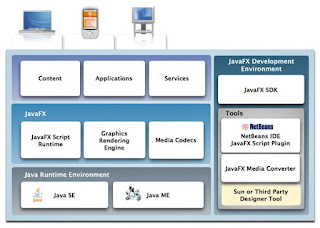JavaFX: Do we need another rich Internet platform?
 Sun’s JavaFX is here. It was announced at the JavaOne conference – in 2007. Sun began delivering early bits of its rich Internet application software this summer. As I wrote about last May, Sun is talking big about having a common display platform for “all the screens of your life,” that is, desktops, notebooks and mobile devices.
Sun’s JavaFX is here. It was announced at the JavaOne conference – in 2007. Sun began delivering early bits of its rich Internet application software this summer. As I wrote about last May, Sun is talking big about having a common display platform for “all the screens of your life,” that is, desktops, notebooks and mobile devices.
It’s a good plan, and Sun has delivered on the first part this week, offering JavaFX 1.0 for Windows and Mac desktops. But what’s missing, beyond the mobile code (which is due next year) is any originality.
Beyond plug-ins for NetBeans, I haven’t seen Sun articulate any clear advantage for JavaFX 1.0 over the mature offerings from Adobe and Microsoft.
It’s a competitor without a message.
That’s not necessarily bad: Adobe must not be allowed to dominate the market without a fight, and there’s no way that Sun could watch Microsoft enter the market without offering its own platform. (It’s disappointing that Sun is offering an Eclipse plug-in for JavaFX developers, but isn’t offering one for Visual Studio.)
In fairness, I believe that Sun’s JavaFX plans were hatched totally independently of Microsoft’s Silverlight plans. Sun’s prizes are mobile devices, where its other technologies already have an edge, and which represent the biggest licensing opportunity. Frankly, I’m surprised that Sun didn’t focus on delivering mobile code first, leaving the desktop for later.
However, while Sun’s entry isn’t necessarily bad, it’s not necessarily good either. Without articulating a clear vision for JavaFX, or demonstrating why JavaFX solves problems that its competitors can’t, I don’t see why any but the most Sun-centric developers would target it.
